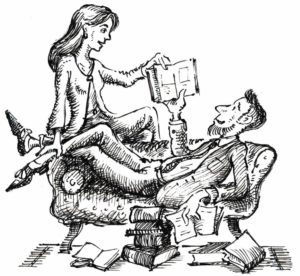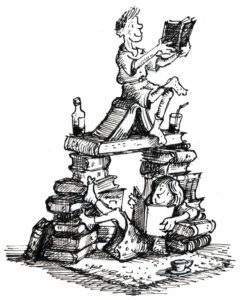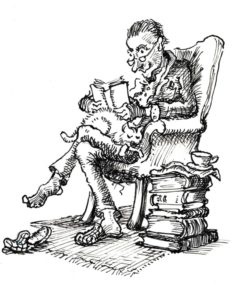The Short Story in America
from The London Daily News, October 14, 1893
“The Congress of Literature was held at Chicago,” says Mr. Walter Besant in a letter to The Times, “at a fitting moment. It may be taken,” Mr. Besant says, “as the inauguration of a new literature which has just begun to spring up in the West — a literature of which I for one was profoundly ignorant until I learned about it on the spot.” Now this is exactly the literature about which England is just beginning to learn. “At present,” says Mr. Besant, “it exists chiefly in promise; but if it is a bantling, it is a vigorous bantling.” Yes, we should say that it was a decidedly vigorous bantling.
The North American telling of short stories is as yet only in its infancy. When we speak of North America, we speak of course concerning the whole vast population who live between Lake Superior and the Gulf of Mexico — between the Narrows of New York and the Golden Gate of San Francisco. Within these somewhat expansive limits a new literature is expanding every day. America is being discovered and by native discoverers quite unlike Christopher Columbus or the more or less legendary Prince Madoc. America is being discovered all over again by the native writers who have the gift to write about her. We learn all about the ways of the different States and counties and townships in the United States by the instruction of a number of young writers, who flash the whole story for us with the vigor of impressionists in art, combined with a certain gravity and stillness in their work which the mere impressionist does not always secure. There are, in fact, American short stories coming up which have to be regarded as serious works of literature, but which hardly get known as well as they ought to be known on this side of the ocean. The number of merely Western stories which are growing up in American literature is something quite portentous. The number of these stories which can claim distinctly literary and artistic merit is something more portentous still. Mr. Besant mentions by name several of these new-comers, men and women. He names many names which as yet are hardly known to this country. But he mentions, on the other hand, some names which, all unknown the other day, are already beginning to be popular, not to say dear and famous, among the readers of the old country.
We have little idea in England generally of the infinite varieties of life and of conditions and of manners which forbid the American people from being described as one homogeneous population. Therefore we are most of us a little surprised perhaps to find that there is an American village literature, if we may call it so, springing up everywhere in America which accentuates the manners of each little community, and makes a perfect photograph of the life of each city and each village. We began to learn something — most of us — from “Elsie Venner” and from “The Blithedale Romance.” After these works of Eastern literature came Bret Harte and his life of the canvas town and the prairie. No one can doubt that the American life pictured by Bret Harte was a revelation for Eastern America and for Europe. The days of the canvas town have passed away. Solid cities stand, with opera house and electric light, where canvas tents were once spread over the prairie and where the click of the revolver was familiar, and the news of “a man for breakfast” was not regarded with any astonishment. But although the more startling occurrences in far western life have gone well nigh out of memory, there is still a western life which is unlike any other life and which has its clever chroniclers. There is a life of Western America which is still admirably and faithfully described by chroniclers who work, indeed, in the spirit of Bret Harte, but who are not by any means servile followers of his method. It is curious and interesting to note how many clever and even we might say brilliant stories of American life are written by American authors whose names as yet are hardly known in England. The names of these really gifted and successful story writers will be known here one day — we cannot have much doubt about that. Some of us can remember taking up a book at an English railway station, and finding it called “The Scarlet Letter,” by one Nathaniel Hawthorne, previously unknown to us, and reading it and finding new thoughts and new conditions of life revealed to us. In the same sort of way we now and then come on a story of American life — it may be Western, it may be Eastern — which fills us with the idea of a new discovery. The Americans have no doubt, like the French, a gift of short stories. Perhaps in time we shall learn from them, as hitherto we have failed to learn from the French, the gift of telling short stories.
The Americans certainly have developed the gift to a marvellous extent. Mr. Besant mentions the names of several authors — we could mention the names of others — who have developed and exhibited this gift. During the last few years quite a considerable number of American men and women appear to have arisen who are endowed with this peculiar gift of telling short stories. We need hardly speak of a woman like Miss Mary E. Wilkins, who can tell short stories with a concise art which France never surpassed, and with a purity which France apparently never troubled itself to equal. The stories of Miss Wilkins are, of course, limited in their range. They deal with the lives of a certain class of people in the villages of New England — with a poverty which, unlike English poverty, is never associated with dirt, with a narrow and pinched and bounded life which had little to do with passion and little to do even with love, but which, nevertheless, had much to do with suffering of its own kind and aspiration in its restricted way. Even since the early stories of Miss Wilkins we have had an outpouring of short stories following hers in order of time, but hardly to be associated with hers in the sense of artistic imitation; stories describing the newer life of the West just as her stories described the newer life of the East. Hawthorne described one sort of the life of the East. He pictured olden Salem and the ancient parts of Boston and the attempt at Socialism which is made fascinating in “The Blithedale Romance.” Miss Wilkins discovered a humbler, less miraculous and more realistic, although not more real, form of New England life in the outskirts of Boston and under the very shadow of Brook Farm. In the same sort of way the tracks of Bret Harte have been followed up, not merely followed. Bret Harte opened up to Europe, and even to America, the life of the California canvas town — its conditions, its hand-to-mouth moral principles, its inevitable disregard of the way of civilized society, its rigid enforcement of a set of principles which sprang up out of the very gold dust and the very sand. There are coming up now in America authors who see the society described in the first instance by Bret Harte with eyes which look keenly and honestly on the newer conditions of life that have grown up since the days when Bret Harte first opened that new vein in modern literature. Every day it would seem some American publisher brings out a really good volume of short stories by an American writer. We do not get anything quite original, but we get very good modifications of conditions which once allowed of originality. Certainly the American short story of to-day, whether it has to do with Eastern life or Western life, whether it be of the New England village or the Iowa prairie, has a vigor and a reality that, told however often, carry originality with them. The great cities of the American Republic have not yet found, so far as we can see, their inspired chroniclers and their prose poets.






